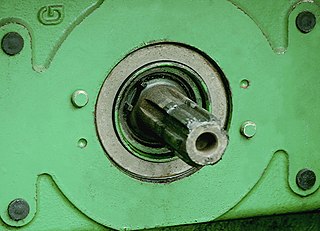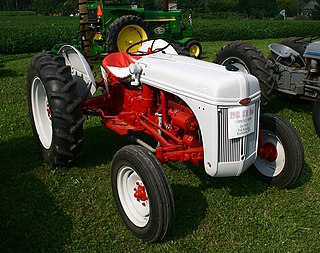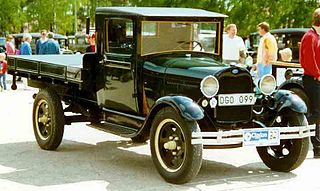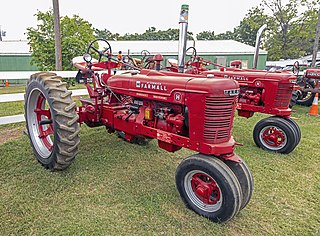
A tractor is an engineering vehicle specifically designed to deliver a high tractive effort at slow speeds, for the purposes of hauling a trailer or machinery such as that used in agriculture, mining or construction. Most commonly, the term is used to describe a farm vehicle that provides the power and traction to mechanize agricultural tasks, especially tillage, and now many more. Agricultural implements may be towed behind or mounted on the tractor, and the tractor may also provide a source of power if the implement is mechanised.

A power take-off or power takeoff (PTO) is one of several methods for taking power from a power source, such as a running engine, and transmitting it to an application such as an attached implement or separate machine.

The Chevrolet El Camino is a coupé utility vehicle that was produced by Chevrolet between 1959–60 and 1964–1987. Unlike a standard pickup truck, the El Camino was adapted from the standard two-door Chevrolet station wagon platform and integrated the cab and cargo bed into the body.

The Jeep CJ models are a series and a range of small, open-bodied off-road vehicles and compact pickup trucks, built and sold by several successive incarnations of the Jeep automobile marque from 1945 to 1986. The 1945 Willys Jeep was the world's first mass-produced civilian four-wheel drive car.

The Dodge Power Wagon is a four-wheel drive medium duty truck that was produced in various model series from 1945 to 1980 by Dodge. The Power Wagon name was revived for the 2005 model year as a four-wheel drive version of the Dodge Ram 2500. As a nameplate, "Power Wagon" continues as a special package of the four-wheel drive version of 3/4 ton Ram Trucks 2500 model.

The Ford Super Duty is a series of heavy-duty pickup trucks produced by the Ford Motor Company since the 1999 model year. Slotted above the consumer-oriented Ford F-150, the Super Duty trucks are an expansion of the Ford F-Series range, from the F-250 to the F-550. Rather than adapting lighter-duty trucks for heavier use, Super Duty trucks have been designed as a dedicated variant of the Ford F-Series, including pickup trucks and chassis cab vehicles; the Ford F-450 is the largest pickup truck offered for sale in North America.

The Ford N-series tractors were a line of farm tractors produced by Ford between 1939 and 1952, spanning the 9N, 2N, and 8N models.

Ford Model AA is a truck from Ford. As the Model T and TT became obsolete and needed to be replaced, Henry Ford began initial designs on the Model A and Model AA in 1926. Basic chassis layout was done rapidly and mechanical development was moved forward quickly. Body design and style was developed and then outsourced to various body manufacturers, including Briggs and Murray. The designs of the Model A shared parts and materials with the Model AA Ford, notably the body, engine and interior. The AA usually received plainer interiors than their car counterparts. The Model AA followed similar design changes to the Model A during the AA's four years in production, often delayed anywhere from three to nine months. The mechanical changes and upgrades were done during production of the vehicles. Body changes that occurred between 1929 and 1930 were also integrated into AA production, but leftover parts were used longer in the heavy commercial trucks.

The Ford Falcon (FG) is a full-sized car that was produced by Ford Australia from 2008 to 2014. It was the first iteration of the seventh and last generation of the Falcon. Its range no longer featured the Fairmont luxury badge, replaced instead by the G Series.

The Allis-Chalmers D series is a line of tractors made by the Allis-Chalmers Manufacturing Company from 1957 to 1969.

The eighth generation of the Ford F-Series is a line of pickup trucks and light- to medium-duty commercial trucks produced by Ford from 1987 to 1991. While the 1980 cab and chassis was carried over to the new model, the 1987 model was more streamlined, and maintenance items were made simpler. The exterior was facelifted with new composite headlamps, a more aerodynamic front end, and circular fenders. Inside, the interior was given a complete redesign. Rear antilock brakes were now standard, the first pickup truck to boast this. For the first time, all models were produced with straight-sided Styleside beds; the Flareside bed was discontinued except for a small number of early 1987 models using leftover 1986 beds with new circular fenders. In 1991 Ford premiered the 9th gen tail lights on the last year of the 8th generation.

The Ford NAA tractor is a tractor that was introduced by Ford as an entirely new model in 1953 and dubbed the Golden Jubilee.

The Farmall H is a medium-sized two-plow row crop tractor produced by International Harvester under the Farmall brand from 1939 to 1954. It was the most widely produced of International Harvester's "letter series", with approximately 390,000 produced over the 14-year run. It succeeded the Farmall F-20. The H was incrementally updated with new model numbers as the Super H, 300, and 350, but remained essentially the same machine. The original H used an International Harvester C152 4-cylinder in-line engine. Production of all versions lasted until 1963.

The Farmall 06 series tractors are a family of row-crop tractors with six-cylinder engines, providing greater horsepower than the parallel product line of four-cylinder Farmall 04 series tractors. Until the late 1950s, Farmall and parent company International Harvester tractors used four-cylinder engines for general-purpose and row-crop tractors. Demands for higher performance and greater horsepower led to broader use of six-cylinder engines, with the bulk of International's production moving to the larger engines. The Farmall 806 and 706 were introduced in 1963, with production running to 1976 and 1967 respectively.. The Farmall 1206 was introduced in 1965 as the most powerful tractor of its time, using a turbocharged diesel engine. Production of the 1206 ran until 1967. The 06 series sold well and was regarded as extremely successful.

The John Deere Model R tractor was John Deere's first diesel tractor. A large, heavy tractor, it had fixed wheel widths and was not produced as a row-crop tractor with adjustable axles. The R was followed in the John Deere numbered model series by the John Deere 80, 820 and 830 tractors, which represented evolutionary upgrades to the basic R.

The Oliver 70 series of row-crop tractors was a series of large agricultural tractors produced from 1935 to 1967 by the Oliver Farm Equipment Company. Oliver tractors were know for their powerful engines compared to competitors, and their attention to styling. The Oliver Hart-Parr 70 marked the beginning of a strikingly-styled series of tractors that were produced under both the Oliver and the Cockshutt names. Oliver's emphasis on styling strongly influenced offerings by competing brands such as Farmall and John Deere.
The Oliver 90 series of row-crop tractors was a series of agricultural tractors produced from 1937 to 1961 by the Oliver Farm Equipment Company. Beginning with the Hart-Parr 28–44, the series was the most powerful Oliver tractor offering, capable of heavy plowing. Initial development proceeded on parallel lines, with the 28–44 offered with low and high-compression engine options that became the Oliver 90 and 99, respectively. The lines merged with the Super 99, then diverged again with the 950, 990 and 995 models. The series was produced until 1961.

The Oliver Super 55 series of utility tractors was developed and produced from 1954 to 1975 by the Oliver Farm Equipment Company to complement the Oliver line of heavy row-crop and standard agricultural tracts. Like row-crop tractors, the wheel track width could be adjusted to conform to crop row spacing, but the front wheels were only offered with a wide track. No narrow front wheel options were offered, making the tractor more stable with front-end loaders.

The Cockshutt 40 row-crop tractor was the second tractor produced by the Cockshutt Plow Company, from 1949 to 1958. Having developed the medium-sized Cockshutt 30, Cockshutt developed the heavier 40, using a six-cylinder engine. The 40 was rated for four plows. It was sold in the United States as the CO-OP E4.


















